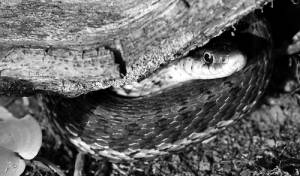Earth Notes: Let Nature Teach

UNEXPECTED SIGHT — While sitting in the forest, Bridie McGreavy noticed she had some company — this garter snake, which was curled up under roots of a nearby tree.
By Bridie McGreavy
“Let Nature Be Your Teacher†is a much-loved refrain in the field of environmental education.
The line comes from a William Wordsworth poem in which he directs readers to, “Come forth into the light of things†by letting nature teach us. What does it mean to let nature be a teacher? In my search to answer this question, I uncovered at least two ways of thinking about this, both of which connect with another line in the Wordsworth poem in which he says, “Bring with you a heart, that watches and receives.â€
I walk every day, partly for exercise but mainly because I love to walk. But, my walks are actually more about sitting and I measure the distance not in miles but in sit spots. I either walk to my first sit spot (on an easy day) or my second sit spot (on an average day) or my third, fourth or fifth sit spots (on days when I could go forever).
One day this spring, I was sitting in one of my several spots in the woods on a sandy beach at Fields Pond in the late afternoon watching the pond grasses extend as reflection into the water when I became aware that I was not alone. I turned my head and met the gaze of a garter snake curled under the root of a tree staring at me as we both soaked up the sun. The snake was almost perfectly camouflaged with its brown and gray mottled bark scaly skin. In this one encounter, nature taught me that snakes (or at least one) bask there to carry body warmth through the night; that the root space was the perfect size for a large snake or other similarly sized creature; and that no matter where I am, I am never alone.
From sitting in nature, I have learned the common fragility of dragonfly metamorphosis, the contrasting blue of hermit thrush eggs, the coordinated yips of coyotes calling across an open wetland at full moon rise and many more richly textured experiences. In this first thread, nature is teacher, literally. By cultivating a practice of sitting, we create a space for our heart to watch and receive and we allow nature to show up and teach us things.
In a second and slightly more removed sense, nature, like any good teacher, helps us remember. Staying with the theme of garter snake, I recently found a dead one on the road. As far as I could tell, it had not been run over by a car and its body was still warm. I think a bird or cat may have killed and dropped it there. Because I use bones to teach the ecology of animals, I collected it, noticing as I lifted it off the pavement that its belly was swollen. From my previous research, I knew that some snakes bear live young and others lay eggs, but I could not remember which was true for garter snakes. The world is a complex place with lots of information to organize and remember. While I have read about garter snakes, this particular fact about their life history escaped me. That is, until I set the snake in a box to let it decompose so I could mount the skeleton. As flesh gave way to bone, multiple small spinal columns tumbled out and I knew then that garter snakes are viviparous, meaning they bear live young.
Now that I have this embodied observation to attach to this fact, I will likely always remember this about garter snakes and carry a deeper awareness of who they are, what they do, and how they participate in the ecology of fields and forests. Nature provides a place to hang our memories, making things we read about real.
When we create a space in our lives for nature to teach, we learn more than we ever knew possible. If we are to preserve the stunning complexity in this assemblage of living and non-living parts through this era of human-induced global change, we must grow our understanding of how to achieve balance. Nature itself may bring the knowledge we need, if we learn to listen with our hearts.

